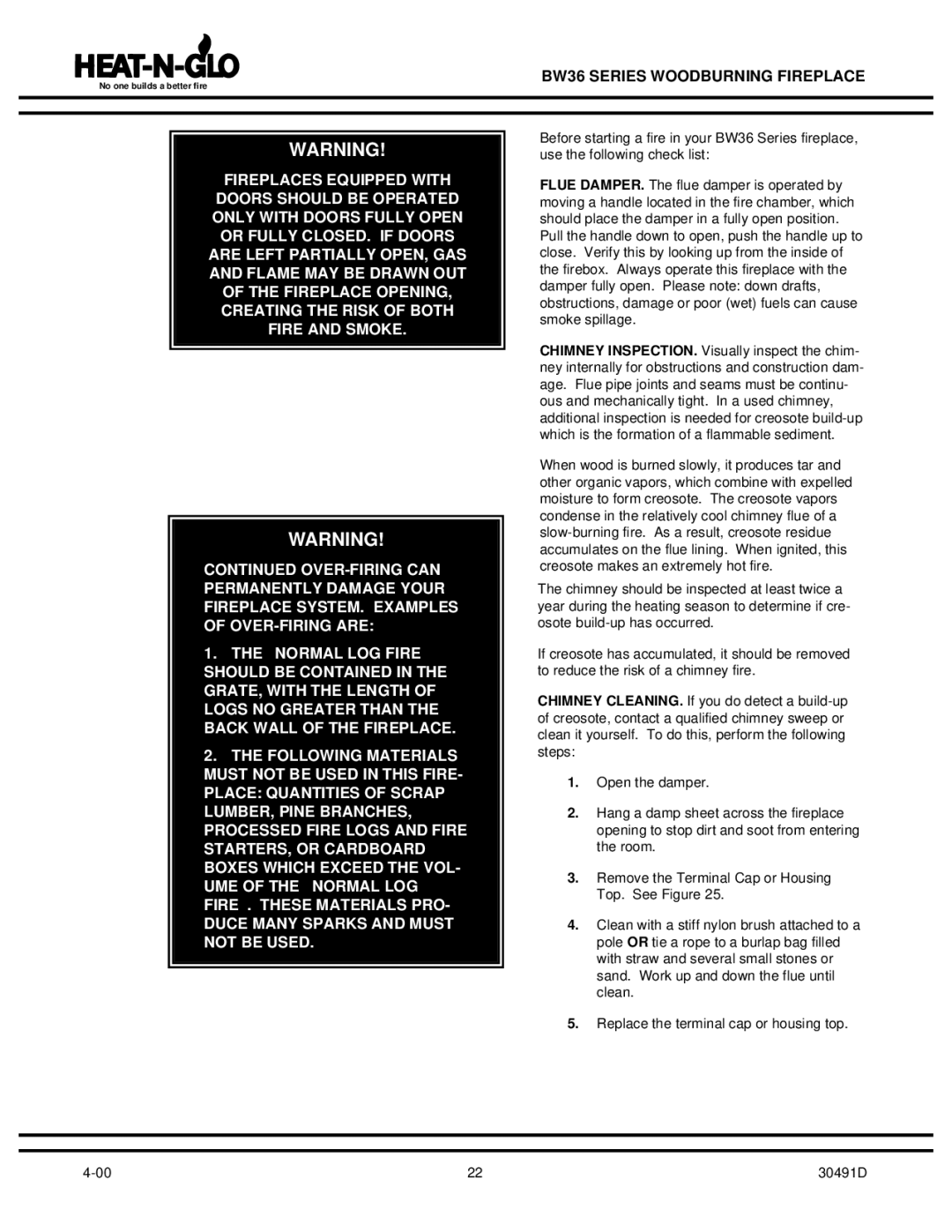
No one builds a better fire
WARNING!
FIREPLACES EQUIPPED WITH
DOORS SHOULD BE OPERATED
ONLY WITH DOORS FULLY OPEN
OR FULLY CLOSED. IF DOORS
ARE LEFT PARTIALLY OPEN, GAS
AND FLAME MAY BE DRAWN OUT
OF THE FIREPLACE OPENING,
CREATING THE RISK OF BOTH
FIRE AND SMOKE.
WARNING!
CONTINUED
PERMANENTLY DAMAGE YOUR
FIREPLACE SYSTEM. EXAMPLES
OF
1.THE “NORMAL LOG FIRE” SHOULD BE CONTAINED IN THE GRATE, WITH THE LENGTH OF LOGS NO GREATER THAN THE BACK WALL OF THE FIREPLACE.
2.THE FOLLOWING MATERIALS MUST NOT BE USED IN THIS FIRE- PLACE: QUANTITIES OF SCRAP LUMBER, PINE BRANCHES, PROCESSED FIRE LOGS AND FIRE STARTERS, OR CARDBOARD BOXES WHICH EXCEED THE VOL- UME OF THE “NORMAL LOG FIRE”. THESE MATERIALS PRO- DUCE MANY SPARKS AND MUST NOT BE USED.
22 |
BW36 SERIES WOODBURNING FIREPLACE
Before starting a fire in your BW36 Series fireplace, use the following check list:
FLUE DAMPER. The flue damper is operated by moving a handle located in the fire chamber, which should place the damper in a fully open position. Pull the handle down to open, push the handle up to close. Verify this by looking up from the inside of the firebox. Always operate this fireplace with the damper fully open. Please note: down drafts, obstructions, damage or poor (wet) fuels can cause smoke spillage.
CHIMNEY INSPECTION. Visually inspect the chim- ney internally for obstructions and construction dam- age. Flue pipe joints and seams must be continu- ous and mechanically tight. In a used chimney, additional inspection is needed for creosote
When wood is burned slowly, it produces tar and other organic vapors, which combine with expelled moisture to form creosote. The creosote vapors condense in the relatively cool chimney flue of a
The chimney should be inspected at least twice a year during the heating season to determine if cre- osote
If creosote has accumulated, it should be removed to reduce the risk of a chimney fire.
CHIMNEY CLEANING. If you do detect a
1.Open the damper.
2.Hang a damp sheet across the fireplace opening to stop dirt and soot from entering the room.
3.Remove the Terminal Cap or Housing Top. See Figure 25.
4.Clean with a stiff nylon brush attached to a pole OR tie a rope to a burlap bag filled with straw and several small stones or sand. Work up and down the flue until clean.
5.Replace the terminal cap or housing top.
30491D
